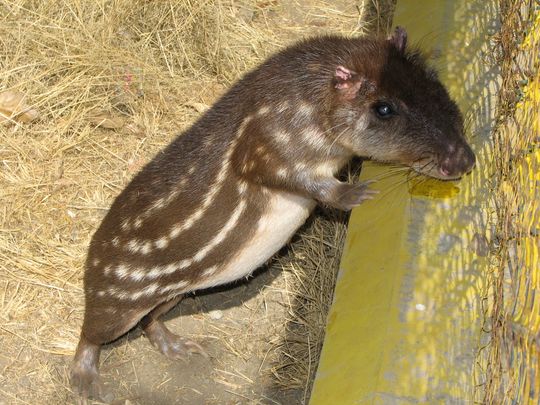
Lowland paca, or Spotted paca(Cuniculus paca, orAgouti paca)
Phylum —chordata
Class — mammalia
Order — rodentia
Family — cuniculidae
Genus – cuniculus
Appearance
The Lowland paca has coarse fur without underfur, dark brown to black on the upper body and white or yellowish on the underbelly. It usually has three to five rows of white spots along its sides, against a dark grey background. It has thick strong legs, with four digits in the forefeet and five in the hind feet (the first and fifth are reduced); the nails function as hooves. The tail is short and hairless. The zygomatic arch is expanded laterally and dorsally and is used as a resonating chamber - a unique feature among mammals.
An adult Lowland paca weighs between 6 and 12 kilograms (13 and 26 lb).Average adult length ranges from between 65 to 82 cm in males and 60 to 70 cm in females.
Habitat
Lowland pacas live in the neotropical parts of the Americas, from northeastern Mexico to Paraguay and northern Argentina, as far as southeastern Brazil.
Behavior
The Lowland paca is mostly nocturnal and solitary and does not vocalize very much. It lives in forested habitats near water, preferably smaller rivers, and dig simple burrows about 2 m (6 ft 7 in) below the surface, usually with more than one exit. It can also sometimes live in burrows created by other animals. The Lowland paca is a good swimmer and usually heads for the water to escape danger, as it can stay under water for several minutes. It also is a very good climber and it searches for fruit in the trees.
Diet
The Lowland paca can be considered an important seed distributor, since its diet includes leaves, stems, roots, seeds, and fruit, especially avocados, mangos and zapotes. It sometimes stores food.
Reproduction
Pacas are sexually mature at about 1 year. They usually have one to three young a year with a gestation period of about 115–120 days.Each litter has one young Lowland paca, sometimes two.
A paca usually lives up to 13 years.
Incaptivity
It is very easy to make paca domesticated and tamed. It quickly and easily gets used to a person.
To keep the paca, you need a large aviary for walking, which would necessarily have a huge bush and a clean pond. For wintering, a warm house is made.
In captivity, they are omnivores. They are fed large-sized rodent pellets containing vitamins and minerals, fruits and vegetables, as well as raw meat, lizards and insects.
 Russian
Russian
 English
English
























